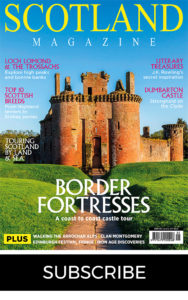MORE FROM SCOTLAND MAGAZINE
Edinburgh: A tale of two cities
Planning your next visit to Edinburgh, Scotland’s enigmatic capital? Read our editor Sally Coffey’s guide to the city before you book
For a compact city, Edinburgh packs a big punch. There’s no doubt it’s Scotland’s most handsome city – with the medieval street plan and Reformation-era buildings of the Edinburgh Old Town on one side of Princes Street Gardens, and the neoclassical squares and terraces of the New Town on the other, it was rightly declared a World Heritage Site in 1995.
It’s this dual personality that gives Edinburgh its eternal appeal, and to really understand the city, you simply must experience both sides. With Waverley train station conveniently placed between the two sides, Edinburgh is relatively easy to explore on foot – though climbing the steep steps that mark the entry to the Edinburgh Old Town to reach the Royal Mile, certainly takes some stamina (taxis are readily available if you’d rather).
Edinburgh Old Town History
The Royal Mile is the name given to the bustling thoroughfare that connects Edinburgh Castle at the top with the Palace of Holyroodhouse at the bottom. It didn’t get its ‘Royal Mile’ moniker until 1901, when author W M Gilbert described it thus in his book, Edinburgh in the Nineteenth Century, and it’s a Scots mile, which is about 200 yards longer than the English equivalent.
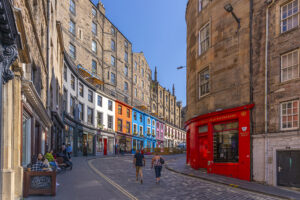
Of course, it wasn’t always a thoroughfare either. Until the 18th century, the Old Town, including the castle, was enclosed by the city walls, which hemmed it in around halfway down the Royal Mile. Conditions within had grown increasingly cramped, leading to the nickname Auld Reekie (meaning ‘Old Smokey’), first coined in the 17th century, referring to the heavy smog that hung over the city from the open fires in the high tenement buildings.
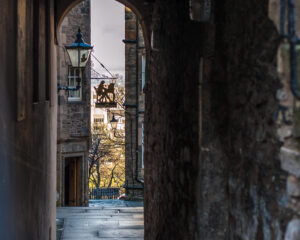
By the 18th century, living conditions had become so bad in the Old Town that plans were drawn up to create a New Town on the other side of Nor Loch (today Princes Street Gardens).
Edinburgh New Town History
A relatively unknown architect called James Craig won the bid to design the New Town, and though work began in the 1760s and the area soon became a hotbed of ideas during the Scottish Enlightenment, as Edinburgh’s greatest thinkers and the highest members of society moved in, the project wasn’t completed until the 1820s.
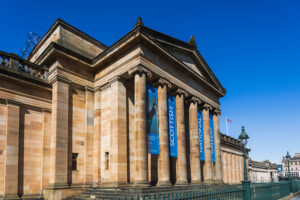
As work progressed, the plan grew more and more ambitious, with new architects employed to extend the Edinburgh New Town. Robert Adam was the creative mind behind stunning Charlotte Square, while William Playfair created both The National Gallery and The Royal Scottish Academy – buildings that incorporate many Greek revival features, such as columns and statues of goddesses, as was the fashion of the time.
It’s the Parthenon-style National Monument, stood atop Calton Hill, that borrows the most from Ancient Greece, though – a lasting reminder of Edinburgh’s attempt to shake off its not-very-flattering Auld Reekie label, and be assigned the title of ‘Athens of the North’ instead.
And so, Edinburgh’s tale is very much one of two cities, and to see one without the other would be doing it (and yourself) a disservice, so I recommend staying a couple of nights in one side of the city and a couple of nights in the other.
Read on for tips on how to enjoy the best of Edinburgh, Old and New.
Edinburgh Old Town
Things to do in Edinburgh Old Town
Queen of the Old Town, indeed Queen of Edinburgh, is the castle, which sits upon its throne of Castle Rock, surveying its subjects, in full view virtually everywhere you go.
For some visitors to Edinburgh, seeing it from the outside is enough, but if you’d like to see the Honours of Scotland (the Scottish Crown Jewels) which were miraculously rediscovered just before King George IV’s historic visit (see page 44) then it’s worth paying the ticket price. The guided tours are also excellent.
A Gothic atmosphere pervades throughout much of the Old Town, where wynds (narrow lanes) and closes snake off the Royal Mile – historic settings of murder and other nefarious activities – and brooding buildings loom above.
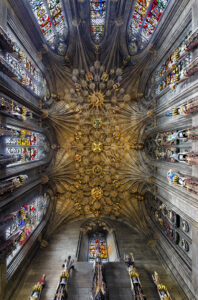
If walls could talk, St Giles’ Cathedral, with its striking crown spire, would have many a tale to tell. It has stood for over 1,000 years and in its time has been a place of worship of such prominent Scots as King David I and John Knox – the latter turned it Presbyterian. The Thistle Chapel, with its intricate carvings, stalls for each of the Knights of the Order of the Thistle – Scotland’s highest order of chivalry has its home here – and vaulted stone ceiling, is a highlight.
The National Museum of Scotland, set on a road just south of the Royal Mile, is a perennial favourite with visitors. Set across seven floors – make sure you take the lift to the 7th-floor roof terrace for great city views – it houses some of Scotland’s most prized items, from artefacts associated with Mary, Queen of Scots, to some of the medieval Lewis Chessmen pieces.
And, of course, you can’t visit Edinburgh and not set foot inside Her Majesty’s official residence in Scotland, The Palace of Holyroodhouse, particularly this year, when the Platinum Jubilee Display, featuring previous Jubilee outfits worn by Her Majesty, is running until 25 September.
Edinburgh New Town
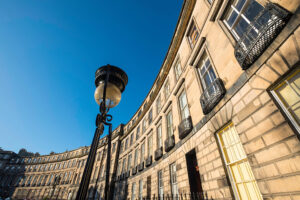
Things to do in Edinburgh New Town
Once the preserve of only the most affluent, the Edinburgh New Town still has something of a sophisticated air about it. At one end sits Charlotte Square – considered by many to be Robert Adam’s masterpiece – and its palace-like frontages make it one of the most prestigious addresses in Edinburgh. The First Minister of Scotland’s official residence, Bute House, is even here.
At the opposing end of the Edinburgh New Town is St Andrew Square, once the city’s business and banking district, and today home to some very good hotels and restaurants. Between the two lies George Street, a smart, handsome street with lots of luxurious restaurants, shops, and hotels.
This is an extract. Read the full feature, in the July/August issue of Scotland, out on 17 June. Buy your copy here.

SCOTLAND MAGAZINE
Published six times a year, every issue of Scotland showcases its stunning landscapes and natural beauty, and delves deep into Scottish history. From mysterious clans and famous Scots (both past and present), to the hidden histories of the country’s greatest castles and houses, Scotland‘s pages brim with the soul and secrets of the country.
Scotland magazine captures the spirit of this wild and wonderful nation, explores its history and heritage and recommends great places to visit, so you feel at home here, wherever you are in the world.
